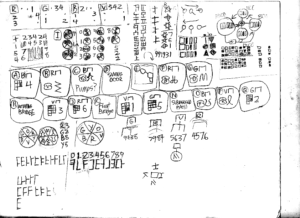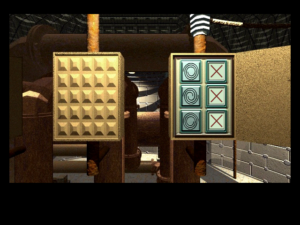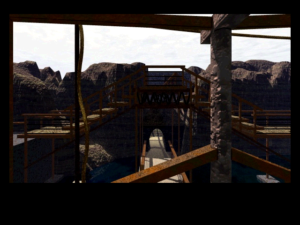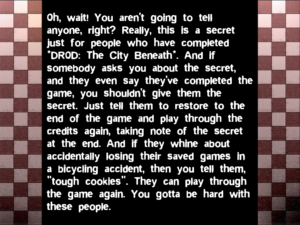Lego Star Wars as a whole
It’s notable that the lego aspect of the Lego Star Wars games isn’t very strong compared to the Star Wars aspect. At no point does the player actually participate in assembling things out of legos. Oh, sure, there are loose piles of legos here and there to be assembled — created, in some cases, when the player blasts an existing lego structure apart — but the player’s involvement in the process is just plunking a character into the middle of the pile, holding down the “action” button, and watching the legos fly to their predetermined spots. Beyond that, lego is basically window dressing on a Star Wars substrate. Like all stylistic aberrations, you get used to it after a while, and basically stop noticing anything strange about it. (With some exceptions, of course. Seeing Lego Slave Leia for the first time was a bit of a shock.)
So where does that leave the Star Wars aspect of the games? If I’m not mistaken, Lego Star Wars and Lego Star Wars II taken together form the only complete game adaptation of the entire 6-episode saga in a single consistent idiom of graphical presentation and gameplay. The closest I’ve seen is a coin-op rail shooter from 1998 that only covered the original trilogy, not the prequels (which hadn’t been released yet). Absurd as it sounds, this makes the Lego games something like the definitive game adaptation of the series.
As such, they provide a good perspective into Star Wars and its relationship with games. It’s hardly news that the prequel trilogy was more videogame-inspired than the original trilogy — the race in Episode 1 and the platformer-like droid factory in Episode 2 in particular have aroused suspicion that they were added to the movies specifically in order to provide fodder for videogame adaptations. “Racing games are popular,” one imagines Lucas saying. “We need a canonical basis for a racing game. Can we use the Endor speeder bikes? Nah, let’s do something more completely like Daytona.” Even if that’s not how it happened, it’s hard to imagine that these scenes could have been produced without anyone involved in the production consciously imitating videogames. The original trilogy, on the other hand, went the other way: instead of videogame-inspired, it was videogame-inspiring. The movies were showing things that couldn’t be effectively done in games yet, but it all looked so cool, and had such obvious promise for the fledgling game medium, that people tried anyway. And they kept trying until the technology caught up and they really could do something that looked as cool as the movies, or cooler. And then they did it again with legos.
As much as I’d like to say that the innovative original trilogy yields better game material than the imitative prequels, it’s just not so. Apart from specific set-pieces, there’s one thing that really separates any game adaptations of the two trilogies: the bosses. The prequel trilogy had a whole bunch of characters that were basically level bosses, such as Darth Maul, Count Dooku, General Grievous — even Sebulba, as the only opponent with a distinct name and personality, is effectively a boss for the Super Anakin Kart sequence. Darth Maul was a disappointment as a character in the movie, especially after all the hype, because all he did was attack the heroes every once in a while. But in a game, that’s not disappointing at all; it’s exactly what we expect. So the prequel trilogy gets a gold star for its colorful array of baddies. In the original trilogy, it’s basically Vader, Vader, Vader. Oh, and briefly Boba Fett, but mainly Vader over and over again, on the Death Star and Bespin and Dagobah (even if that’s just a mystical vision, it’s still a boss fight), until the end, when you fight the Emperor, who isn’t very interesting as a fighter — he basically just zaps one of the two player characters with Force Lightning until you switch to the other character and hit him. They had to turn that scene into a series of platformer puzzles in order to make it viable.
[added June 9 2007] Vader basically has the opposite of Darth Maul’s problem. Unlike Maul, he does a great deal more than just attack the heroes: he captures the princess, interrogates her by extreme means including making her watch him destroy an entire planet, orders underlings around and force-chokes them to death when they fail him, exposes Obi-Wan’s lies, and ultimately switches sides and betrays the Emperor. But only the last of these points translates into gameplay; the rest are shown in cut-scenes, if at all. So he’s less interesting as a videogame character than as a movie character.
 Comments(3)
Comments(3)



